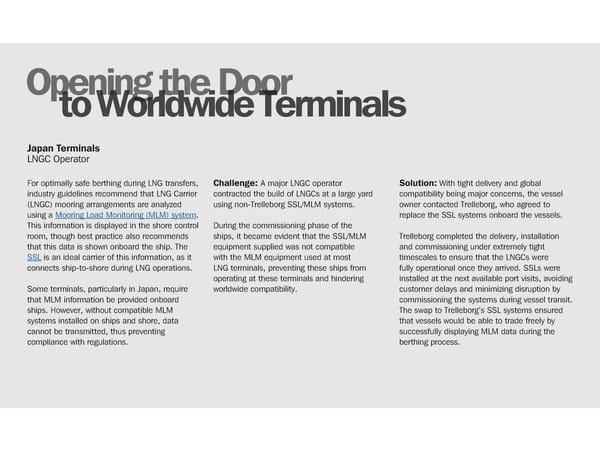Opening the Door to Worldwide Terminals Japan Terminals LNGC Operator For optimally safe berthing during LNG transfers, Challenge: A major LNGC operator Solution: With tight delivery and global industry guidelines recommend that LNG Carrier contracted the build of LNGCs at a large yard compatibility being major concerns, the vessel (LNGC) mooring arrangements are analyzed using non-Trelleborg SSL/MLM systems. owner contacted Trelleborg, who agreed to using a Mooring Load Monitoring (MLM) system. replace the SSL systems onboard the vessels. This information is displayed in the shore control During the commissioning phase of the room, though best practice also recommends ships, it became evident that the SSL/MLM Trelleborg completed the delivery, installation that this data is shown onboard the ship. The equipment supplied was not compatible and commissioning under extremely tight SSL is an ideal carrier of this information, as it with the MLM equipment used at most timescales to ensure that the LNGCs were connects ship-to-shore during LNG operations. LNG terminals, preventing these ships from fully operational once they arrived. SSLs were operating at these terminals and hindering installed at the next available port visits, avoiding Some terminals, particularly in Japan, require worldwide compatibility. customer delays and minimizing disruption by that MLM information be provided onboard commissioning the systems during vessel transit. ships. However, without compatible MLM The swap to Trelleborg’s SSL systems ensured systems installed on ships and shore, data that vessels would be able to trade freely by cannot be transmitted, thus preventing successfully displaying MLM data during the Trelleborg delivered a globally compatible compliance with regulations. berthing process. SSL system that ensured vessels could trade freely, while optimizing a safe and efficient berthing/LNG transfer operation through the provision of MLM data.
 LNG Case Study Brochure | Trelleborg Page 5 Page 7
LNG Case Study Brochure | Trelleborg Page 5 Page 7